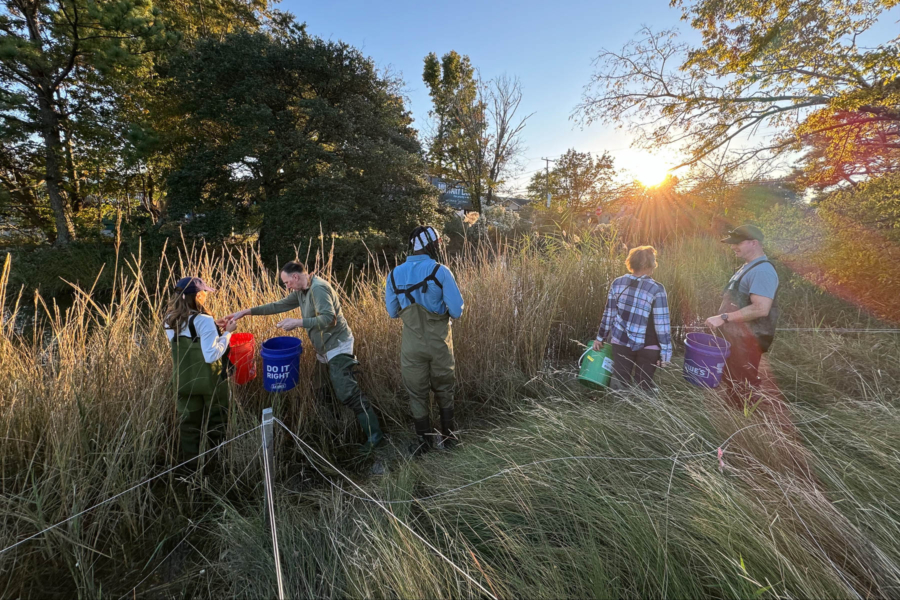Homegrown heroes
The Elizabeth River Project is bringing 200+ year old wetlands back to the river

Each Seed Keeper outing begins with a song.
As volunteers gather along a shoreline of the Elizabeth River, ready to harvest seeds from native wetland plants, group leader Luísa Black Ellis recites a few verses that request permission from the land.
“When we collect seeds, we ask for permission before taking them, and then we do it with a song,” said Black Ellis, director of resilience and community engagement at the Elizabeth River Project (ERP).
The practice is inspired by the Indigenous concept of an Honorable Harvest. Made popular by the book Braiding Sweetgrass by Robin Wall Kimmerer, the concept emphasizes sustainability, showing gratitude for the land and not taking more than what you need.
“It's about creating a relationship and reciprocity with the land,” Black Ellis said.
Historically, people have harvested seeds for food or to plant themselves, but at ERP, the seeds are needed to continue the nonprofit’s extensive wetland restoration work.
However, not just any seed will do. Launched in 2024, ERP’s Seed Keeper Series targets wetlands that have gone undistributed—in some cases for hundreds of years—and are therefore fully acclimated to the tributary’s unique climate.
Believe it or not, a hyper-local wetland is hard to come by in the Elizabeth River watershed. This is because of how many wetlands were removed for development, but also because the grasses used to restore wetlands are typically grown in Maryland, Virginia and even Florida.
“Almost all organizations or companies that are doing this restoration work are getting their [wetland] plants from really far away,” Black Ellis said. “A lot of times we're buying our plants from places like Florida, Delaware or Maryland, which is a little better because it's on the Bay, but it's still a pretty different climate.”
These aren’t non-native or invasive grasses, but ones that were grown in different climates and therefore may lack the genetic makeup to thrive on the Elizabeth River. In some cases, a restored shoreline can be made up of the same grass grown out of state. The concern here is that a disease or climate shift that’s particularly damaging to that plant could wipe out an entire stretch of vegetation.
“We have this double problem now where not only are we getting our wetland plants from Florida, but we're also potentially restoring hundreds and hundreds of acres of shoreline with essentially one specimen,” Black Ellis said.
By harvesting these seeds, ERP is slowly building a library of truly native grasses that can be used for research and eventually planted along the river. The pickings are slim, and the organization has had to dig through development records and rely on word of mouth in order to identify wetlands that they can confirm are natural. So far, they’ve only found a few locations, including 50 acres of intact wetlands that are at least 200 years old.
“It’s difficult to find a confirmed, natural shoreline,” Black Ellis said.
As seeds are being harvested, ERP is working with Old Dominion University (ODU) on research related to native wetlands.
With a grant from the JP Doherty Foundation, researchers at ODU's Wetland Plant and Restoration Lab are conducting a literature review on the existing guidelines and protocols for growing wetland plants from seed, which Black Ellis says is not widely available. The partners will also attempt to propagate the wetland seeds they’ve harvested and plant samples in varying landscapes, including next to existing restoration sites, to evaluate their health.
“What we're really interested in exploring with our researchers long term is, how do the wetlands planted from local genetics perform long term versus shorelines sourced from Florida or Delmarva?” Black Ellis said. “What other ecosystem benefits are hidden there that we don't even know about?”
Besides this research, ERP does not grow the wetlands that it uses for restoration. Instead, the organization is hoping to foster a market for native wetland seeds to be grown and sold by nurseries in the region.
“We're working with commercial growers to help them understand that there's a demand for this regionally,” Black Ellis said.
If anyone could attest to the demand, it would be ERP, who conducted Virginia’s ever first wetland restoration effort on the Lafayette branch of the Elizabeth in 1997. Since then, the nonprofit has been planting and restoring wetlands on private property through their River Star Homes program. When available, the program uses state and city funding to cover part of the costs for landowners.
On April 3rd, the nonprofit will host an event with Diane Wilson, author of The Seed Keeper, to cap off its Seed Keeper Series and unveil their native seed library. Volunteers have helped collect seeds from native wetlands, but also from rain gardens and forests, and these seeds will be available for public use.
Of course, some of the wetland seeds will be kept for ERP’s research and future restoration projects, as they continue safeguarding the Virginia tributary.
“It feels really life-giving and affirming to be doing this,” Black Ellis said. “It’s ancient and collective science together that will have a direct impact on the river.”

Comments
There are no comments.
Thank you!
Your comment has been received. Before it can be published, the comment will be reviewed by our team to ensure it adheres with our rules of engagement.
Back to recent stories